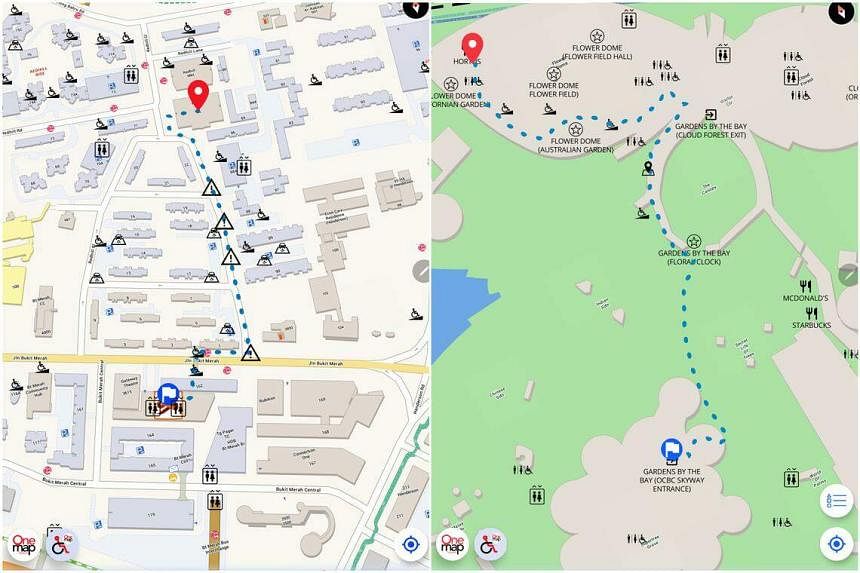SINGAPORE – From March, wheelchair users can find barrier-free routes on the national OneMap app, making it easier for them to navigate different parts of Singapore.
The initiative by the Singapore Land Authority (SLA) to map out such routes will show users features like wheelchair-accessible covered linkways, ramps, footpaths, pedestrian crossings, and overhead bridges with lifts.
About 1,100km of accessible routes have been mapped across nine areas in Singapore.
These are Bukit Merah, Ang Mo Kio, Orchard, River Valley, Marina South – including Gardens by the Bay – the Museum District, Punggol, Singapore River and Tanglin.
The app will also have audio directions for wheelchair users, including alerts when approaching road crossings. Public transport, cycling and driving modes are already available on the app.
The feature will be available for Android users.
From July to October in 2023, SLA conducted four pilot testing sessions together with SG Enable, where more than 100 wheelchair users trialled the app in areas like Gardens by the Bay and around Ang Mo Kio Community Centre.
These users gave feedback and suggested improvements to the app’s barrier-free navigation function, such as having louder and earlier alerts when approaching crossings and using bigger fonts on the map.
SLA is looking at adding an alert for steep ramps and getting the app to reroute to find safer paths.
SLA is now working with SBS Transit on expanding barrier-free routes around the public transportation nodes to cover more areas across Singapore.
Starting with Plaza Singapura and Dhoby Ghaut MRT station, SLA is also looking to expand the app’s barrier-free navigation to indoor spaces, in collaboration with shopping mall owners and transport operators.
Apart from wheelchair users, barrier-free access will also be useful to those with strollers or mobility challenges, said Nominated MP Ong Hua Han, who uses a wheelchair himself.
Another app, SmartBFA, crowdsources data to map out barrier-free routes. Launched in March 2023, the app has collected data on pathways in areas such as Kembangan, Telok Blangah, Raffles Place, Bugis and Toa Payoh.
The app’s team works with volunteers, led by inclusion ambassadors from the Disabled People’s Association who use wheelchairs, to collect data and map out accessible paths.

Mr Kai Reuber, a SmartBFA project lead, said not having enough information about a location’s accessibility prevents wheelchair users from going to new places.
“The most obvious example was during the Covid-19 pandemic, when malls around Singapore blocked off many accessible entrances to adhere to TraceTogether requirements. As a result, many wheelchair users did not venture out much and preferred to stay home,” he said.
Mr Reuber said barrier-free routing should focus on “last mile” navigation from a train station or bus stop, to a place unfamiliar to wheelchair users. He said wheelchair users usually either scout an area for an accessible route a day ahead or use tools like Google Street View to check for kerbs or obstacles. If neither of these are an option, some of them may avoid the area entirely, he said.
Since October 2023, there have also been accessibility maps of Raffles Place showing accessible lifts, entrances and exits to buildings, and sheltered routes.
The maps, created by Raffles Place Alliance, which is made up of 10 founding stakeholders in the area, also show amenities like accessible toilets and wheelchair lifts, and where steep ramps and steps can be found. Interested users can visit rafflesplace.sg/getting-here to find these maps.
Ms Sherena Loh, director of Muscular Dystrophy Association (Singapore) (MDAS), who uses a wheelchair, considers researching and planning her routes as “doing her homework”.
“Our lives are not so spontaneous. If right now you want to call me to go somewhere, if I don’t know its condition, I don’t dare to tell you I can meet you there,” she said.
Ms Judy Wee, MDAS executive director, said how reliable SLA’s barrier-free routing function is will depend on whether it has up-to-date information on construction works.
Having photos of landmarks on the app will also help them assess whether the route is accessible, for instance if ramps might be too steep, narrow or winding, Ms Loh added.
The OneMap app has a feedback form for users to flag potential obstructions.
Going up steep and long ramps can be an uphill battle for financial planner Asyraf Ghazali, who uses a lightweight, foldable manual wheelchair.
He said that uneven ramps can trigger leg spasms, which might displace his legs on his wheelchair and cause him to fall over.
The 28-year-old has used a wheelchair since a road accident in 2018 injured his spine and left him paralysed from the chest down.

Mr Lim Kay Choong, a data operations analyst who uses a motorised wheelchair, said: “If I know earlier that there is construction, I might ask someone to accompany me.”
The 34-year-old said he might get a friend to support him when he is going up a steep path or getting over a kerb.
Mr Asyraf, who tested one of the app’s barrier-free routes in Ang Mo Kio in December, places his phone on the seat of his wheelchair to avoid having to hold on to it and navigate his wheelchair at the same time.
Mr Zahlan Zainal, 47, who took part in one of SLA’s pilot testing sessions, prefers to listen to the app’s audio directions on his headphones while navigating his motorised wheelchair.
Still, unforeseen circumstances can crop up. Wheelchair users can get all the way to an MRT station only to find out the lift is not working, for instance. This information could be made available on platforms such as Telegram channel SG MRT Updates, which gives up-to-date information on train delays, suggested Mr Lim.
Mr Ong, who works in Raffles Place and has tried out the accessibility maps in the area, said they add to the tools available to improve navigation for people with disabilities.
“While infrastructural improvements are still needed to enhance overall accessibility (in Raffles Place), improving wayfinding is certainly complementary to achieving this goal.”
Mr Ong, an assistant vice-president at Deutsche Bank, added that in an accessible environment, workers with disabilities can have lunch at popular spots, see a doctor or run errands during a break.
“If you want to include and encourage more persons with disabilities to be employed, the financial industry is a big employer. Removing physical barriers (in the Central Business District) directly supports this intention.”

